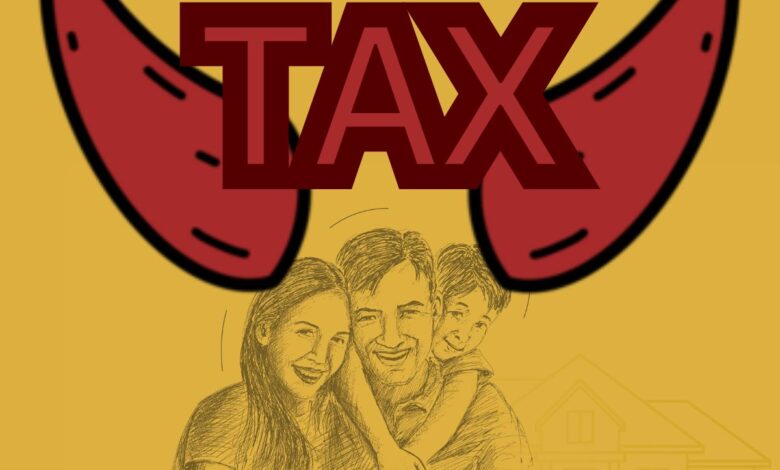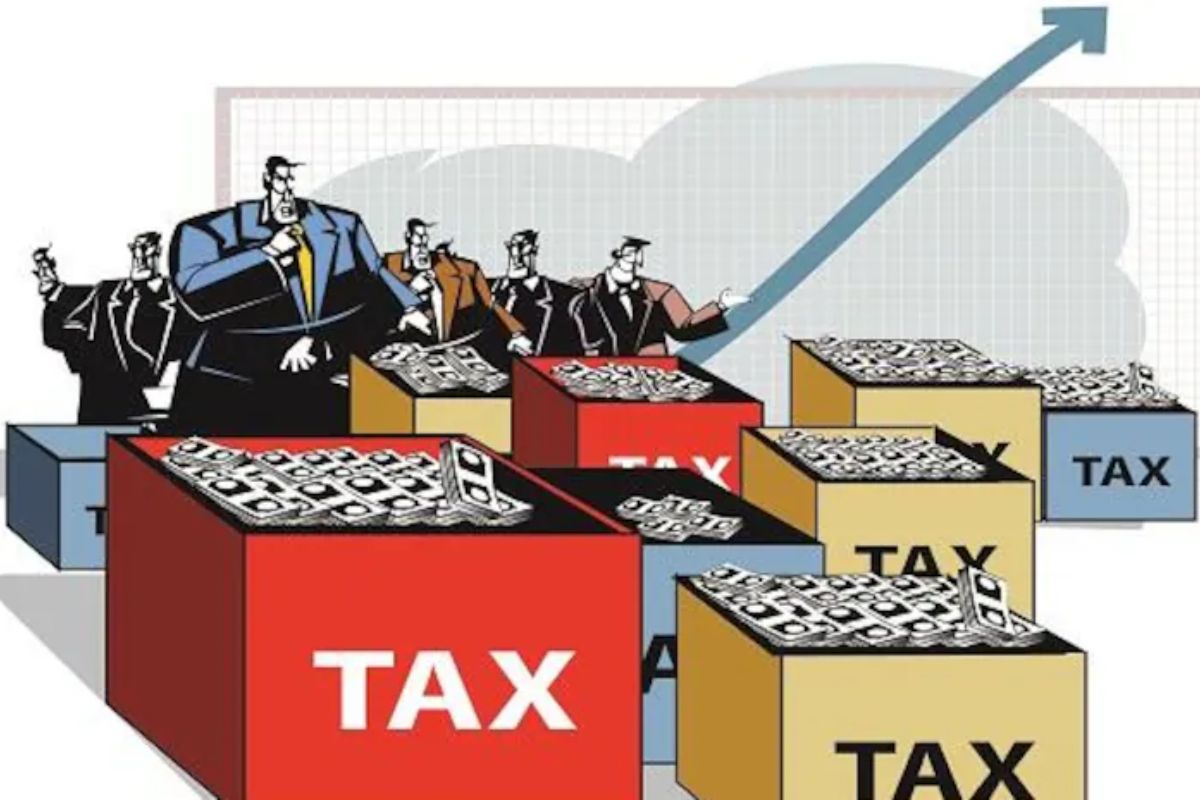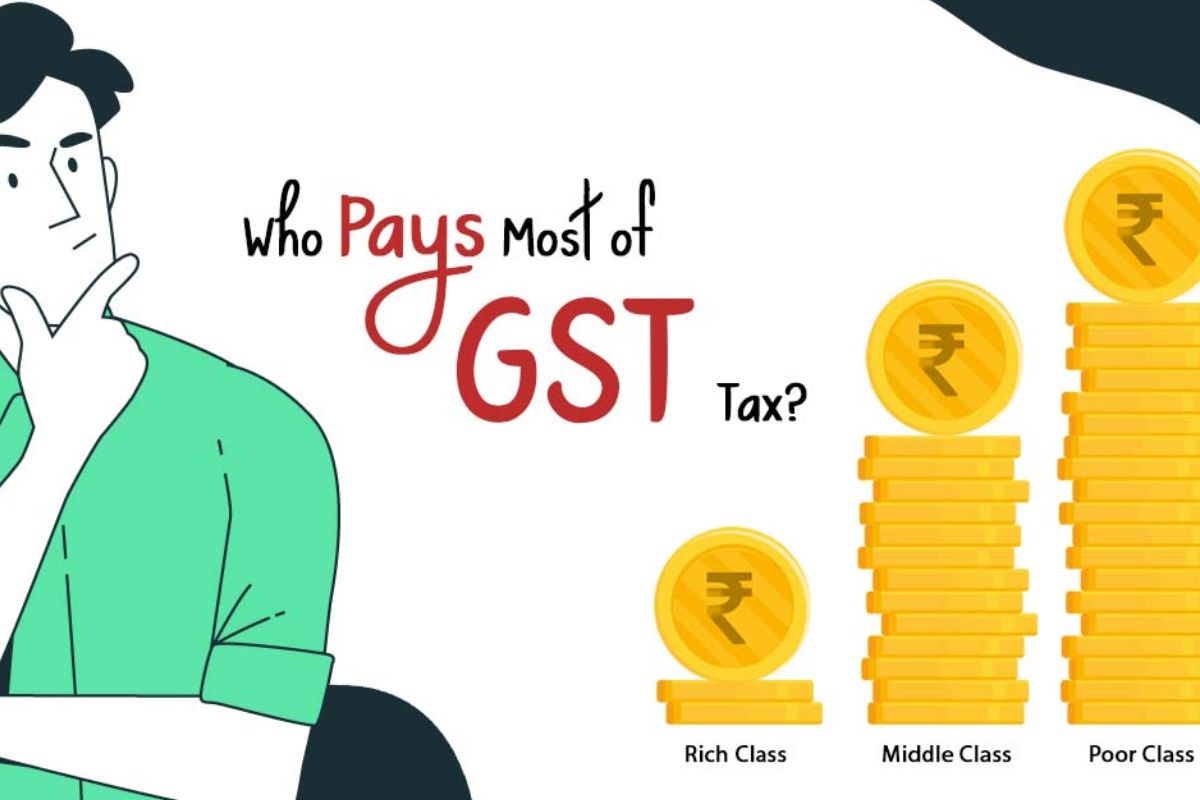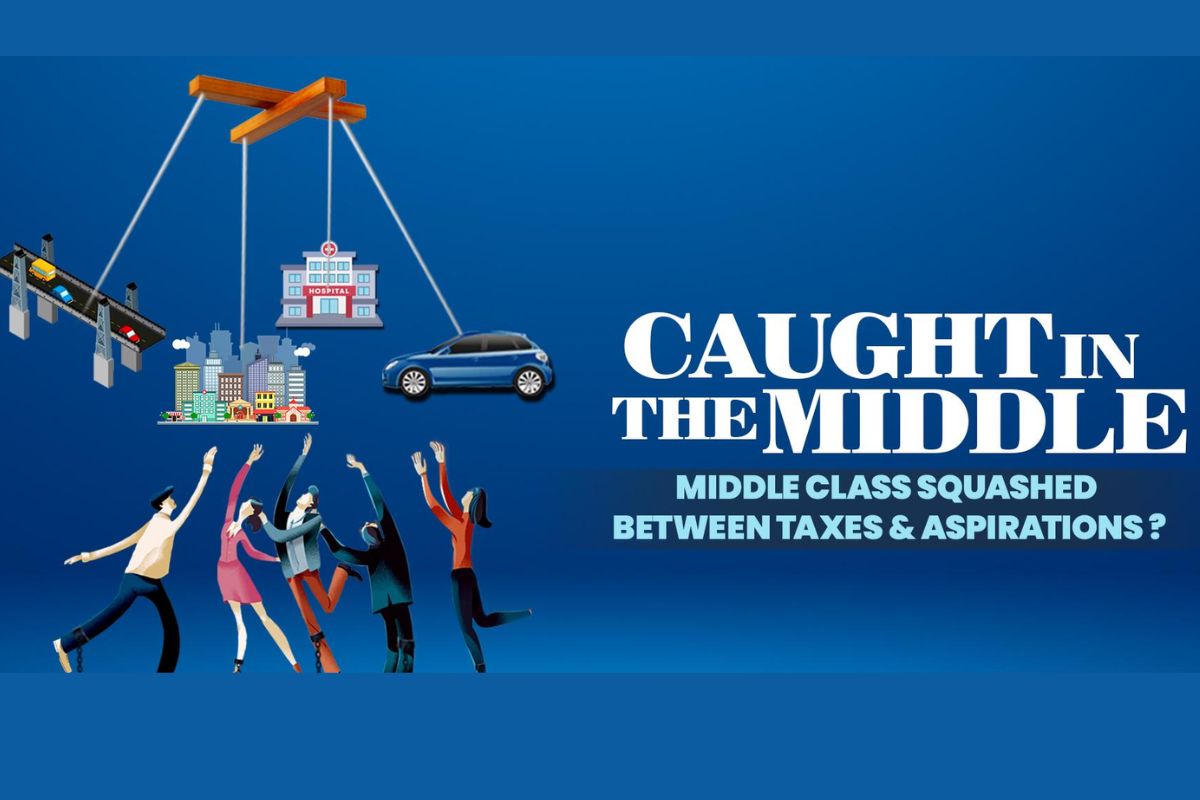Nothing Is Certain, But The Death And Tax, Certainly For The Middle Class, As They Failed To Become The Vote Bank Of The Nation!

“Indians pay taxes like England to get services like Somalia”- In the bombarding rain of July 2024, these statements by educated Indian politician Raghav Chaddha, echoed in the walls of the parliament, depicting how Indian taxpayers are the real minorities with no benefits.
India, a country known for its colourful culture and thriving economy, faces an unexpected reality. Its largest minority is identified not by religion, caste, or race, but by its taxpayers. This segment, mostly the middle class, bears the financial weight of the country’s growth yet frequently feels overlooked and mistreated. In any society, taxpayers are the foundation of economic stability and growth. They contribute heavily to the government’s coffers, giving cushion to a myriad of critical services, which are crafted for improving quality of life of many and fostering economic progress.
But, but, but…. in India, a disturbing narrative is emerging: taxpayers who faithfully execute their financial commitments frequently receive insufficient rewards in return. Instead, they face limited infrastructure, terrible healthcare, and bad public services. This article digs into the issues that this section faces, using real-world facts, expert views, and a comparison to effective tax systems in other nations.
Middle class- The ‘sandwich class’, also the engine of the country’s growth, bears the title of the biggest sufferers.
India’s middle class, estimated to be 432 million strong, is the country’s economic engine. According to the National Council of Applied Economic Research (NCAER), these are the key drivers of consumer spending, savings, and investments, hence powering the economy. However, this section also accounts for the great majority of India’s taxes, serving as the country’s financial backbone. India’s taxable base is minute, even with a generous middle class.
According to data from the IT Department, little over 1.46 crore people—roughly 1% of the total population—filed IT forms in the 2020–21 fiscal year. This statistic highlights a notable disparity where a small percentage of the population is responsible for more than 1.3 billion people’s financial obligations.
The complex tax structure.
The direct tax- on income or profit.
According to figures released by the government in 2023, just 2.24 crore Indians, or 1.6% of the population, paid tax in 2022-23, including income and corporate taxes. India has experienced an increase in direct taxes, which include two components: income tax and corporate tax. Direct tax revenues currently exceed indirect taxes, which is a positive indicator. Here is when the tale takes an unexpected turn. In terms of direct taxes, the individual income tax surpassed corporate taxes in 2022-2023. People, particularly from the middle class, pay more in taxes than corporate.

The highest individual taxpayer in India is not Ambani, not Adani, not Birla, not Hinduja, not Poonawalla… in fact, not anyone among the 100 richest people in India!
India’s income tax structure is progressive, which means higher income categories pay greater taxes. Individuals earning between INR 5 lakh and INR 10 lakh per year pay a 20% tax rate, while those earning more than INR 10 lakh pay 30%. While this aims for equal distribution, it imposes a significant cost on the middle class, especially given the lower effective tax rates in many industrialised countries. Now one may think that why the salaried class is sandwiched.
The fact is that even though there are different slab rates for different income groups, but there are exemptions for many. Agriculture (20% of GDP) is tax-free, and so is export (21%), leaving only 59% of GDP available for taxation. In India, social equality demands a clerk earning Rs 10,000 per month in Mumbai to pay income tax, but a farmer in Punjab’s Gurdaspur earning Rs 1.5 lakh per month to be tax-free.
The “super rich” as government calls it, take advantage of the several system loop holes and get away from paying any taxes. For instance, 67% of population claim tax exemptions agricultural income. Why does a landlord making crores of rupees on agricultural income not have to pay a singe penny as tax?
Also, Businessmen, self-employed professionals and, of course corporates have various ways of dodging taxes, but the salaried man has none, at least as far as his salaried income is concerned. Only one group of people in India cannot escape the clutches of the tax man – the salaried class – because the employer is responsible for deducting tax at source and handing it over to the government. For decades, this group has been the government’s bakra (scapegoat) for collecting income tax (I-T).
Budget 2024 had a small relief for the salaried middle class as the standard deduction in the new regime was raised from Rs 50,000 to Rs 75,000. This, according to calculations, will leave around Rs 17,500 more in the hands of the common people. Seriously, do you think it’s enough?
The increase in income tax collections surpassing corporate taxes comes as the markets have soared, with the benchmark BSE Sensex climbing from roughly 19,000 in 2012 to 80,000 by 2024. In the previous 12 years, stock markets have doubled, suggesting that earnings have increased. However, corporate taxes have declined as a percentage of overall collections. Income tax, which mere % of India’s population pays, is more than corporate tax. This isn’t sustainable in the long run. According to political analyst Amitabh Tiwari, a former investment banker, personal taxes cannot support a middle-income country such as India.
Profits For Corporates Up, But Taxes Down?
There is a popular notion by many in India that the current government is highly inclined and in favor of corporate people. The government reduced corporate tax in 2019, incurring a loss of Rs 1.44 lakh crore a year. The Economic Survey data shows that between FY20 to FY23, corporate profits have quadrupled, which again shows that the corporate sector is performing, but paying less taxes due to tax cuts. This shows that how the corporate and political nexus us working together to squeeze the common citizen in general, and the salaried class in particular.
While corporates got tax incentives in the 2019-20 Budget, individual taxpayers last saw a change in 2012-13. That’s over a decade ago.
The taxes were reduced to boost capital expenditure (capex), create private sector jobs and increase exports. The government’s gamble was that the tax break would boost income and earn it taxes. But that hasn’t been the case. This year, including the distressed equity infusion in BSNL, the total public sector capex-to-GDP ratio is 3.6 percent. It was 3.9 percent before Covid. So, the government is actually doing less capex. This is because the absorption capacity is low, and if that’s the case then how does one invest more in infrastructure.
Navi Mumbai airport was supposed to open in December 2024; it was earlier supposed to open in March 2024. There is doubt it will open in December 2024. Jewar airport was supposed to open two years ago, but now they say it will open in March 2025, there is also don’t see it opening in March 2025. It’s been 10 years since the bullet train project was envisaged, we haven’t seen a bullet train yet.
If this is the state of play with capex wherein projects constantly face time overruns and therefore cost overruns, in that circumstance, fiscal prudence is not just about reducing the fiscal deficit-to-GDP ratio, an important part of fiscal prudence is to not spend money badly and if you know in advance you are going to spend money badly, then don’t spend it. So why the public should not think that the leverage the corporates have been given by reducing their taxes is being misused by the giants and at th end, it is the salaried who is going under the axes.
Also, the the government encourages people to invest in the stock market. Recall Union Minister’s remark before election results mentioning ‘Buy Before June 4’ can be cited as an example. But, when we are feeding 800 million people, when 47 percent of our population depends on agriculture, and when real wages are stagnating, that everyone is wearing a suit and going into the market to play stocks and startups, is not a portrayal of the real world. So at one hand, the salaried class is under the axe of tax, and on the other hand, the upcoming cohort is losing great money in stock markets. God knows what will happen to them.
The draconian indirect taxes- on consumption.
GST.
India collects significantly more money by taxing expenditure, than other countries do, as seen from exponential rising numbers in GST collections. Look at goods and services tax (GST), the main tool for indirect taxation. Who pays so much GST? The Goods and Services Tax (GST) is an important tool for taxing middle-class expenditures. There is relief for corporates, but not for individuals.

Salaried individuals get no refund on GST paid, but corporates get input tax credit. A report from Oxfam states that 64% of India’s GST is paid by the bottom 50% of the population, 33% is paid by the middle 40% and only 3% is paid by the richest 10%. Seen from another angle, the poorest 50% of people spend 6.7% of their income on taxes for select food and non-food items, the middle 40% spends 3.3%, and the top 10% wealth group spends only 0.4%. Yes, ‘essential’ items – wheat, rice, vegetables, medicines, electricity, books and newspapers – are GST-exempt. But people don’t buy only ‘essentials’ and live the life of a hermit; hence, poorer people pay more GST.
Economists will tell you that reliance on indirect taxes—levied on consumption—rather than direct taxes on income or capital, is the main culprit behind a country’s poor getting left behind. Moreover, the political parties do not pay taxes, and the donations given to political parties also have redemptions. So what is the left for the nation?
Prime Minister Narendra Modi said Budget 2024 was for the empowerment of the new middle class. But is it reality? Let’s see.
Since, budget of 2005-06, gold rose more than 10X in last 19 years but tax slabs have not altered much. The basic income tax exemption limit of INR 100000 in the year 2005-06 was worth 145 gm of gold then. However, at INR 2.5 lakh basic exemption limit, it is worth just a tiny 34 gm now. So, poor folks are getting taxed with unchanged rates not factoring adverse consequence of inflation.
At gold standard the tax slab of 10% should start from INR 10 lakh in 20024 which is worth 145g gold. What it means is that while individuals were giving 30% income tax on income above Rs 10 lakh in 2014, they are now giving 30% on a real income of Rs 5.6 lakh, when compared with 2014. This clearly depicts that relatively poorer citizens with lower real income are now paying a more income tax.
Money diminishes in value with time due to inflation. So if tax slabs remain unchanged with time, it would denote that people are paying income tax on lower real income. This has emerged an issue worth serious consideration today. According to budget a decade ago, an income tax rate of 20% was on income above INR 5 lakh and 30% on income above INR 10 lakh. This has remain unchanged in the last 10 years. If we consider average inflation to be 6%, the real value of INR 5 lakh and INR 10 lakh of 2014 would now be INR 2.8 lakh and INR 5.6 lakh, respectively.
What it implies is that while people were paying 30% income tax on income above INR 10 lakh in 2014, they are now paying 30% on a real income of INR 5.6 lakh, when compared with 2014. This clearly demonstrates that relatively poorer folks with lower real income are now paying a higher income tax.
The presentrent taxation system seems to be very tough on the Indian middle class, particularly the lower middle class. The budget of 2005-06, by P Chidambaram, is famous for middle-class friendly and is still remembered as “a dream budget”. In that budget, the FM significantly raised the tax slabs as 10% tax on income above INR 1 lakh to INR 1.5 lakh, 20% tax on income above INR 1.5 lakh to INR 2.5 lakh and 30% tax on income above INR 2.5 lakh.
Let us compare the present tax slabs to that in that dream budget after discounting the consequence of inflation. For this, let’s use gold prices as the metal is worshipped an ideal hedge against inflation. If a tax system vows to be fair in accommodating the dire impact of inflation on the value of income over time, it should dream to reach closer to the gold standard when deciding tax slabs.
Let us compare the tax slabs of year a decade ago (2005-06) to the current ones (2023-2024) in terms of gold weight and its valuation. As per RBI data, the price of 1 gram of gold in 2005-06 was INR 690. So you could have bought 145 gms of gold for INR 1 lakh, keeping in mind that there was no income tax at that level of income back then. If you sell this gold at the current price of INR 7,275/gram (IBJ rates on July 11, 2024), you can easily get INR 10.54 lakh.
What it implies is that going by gold standard, lowest income tax slab of 10% should be charged on those with income above INR 10 lakh to make it inflation-proof, when compared to the tax slab of 2005-06. Similarly, the 20% slab should commence from INR 15 lakh and 30% tax slab from INR 25 lakh if this budget dreams to be another dream budget.

The government may claim that it has done its utmost to reassure middle-class taxpayers by implementing a new tax system with a considerably lower tax rate on higher income and no tax on income up to INR 7 lakh. However, the new tax policy eliminates the large deductions and exemptions that were available under the previous tax regime. There is no motivation for a person who is already saving money on taxes to switch to the new tax structure.
This is a problem because people organise their home finances in such a manner that they minimise their income tax bill over time. Many taxpayers who bought homes with a 25-year home loan repayment plan failed to account for future tax changes. Similarly, people made financial decisions like as investing in the PPF for 15 years and Sukanya Samriddhi Accounts for even longer. House rentals have risen dramatically throughout this period, but the house rent allowance (HRA), which provides significant relief to taxpayers, is only accessible under the old tax scheme.
To say the least, tax exemptions in India are limited. The new tax system eliminates any tax savings, and the government has begun taxing even government-supported retirement savings/investment choices such as EPF. The exclusions under the previous regime were also not updated in over two decades, despite the fact that wages and the cost of leaving had increased by at least fivefold. To summarise, a hard-working paid employee works 7 months out of 12 for the government and the remaining 5 months for themselves. This is something the controversial shark Mr Ashneer Grover, a year ago said, that India’s tax system is punitive!
The problem of more tax is not a problem- but in return what we are getting is a point of question?
The salaried class in India pays income taxes ranging from 33% to 42% of their income now. This is higher than any developed capitalist country, such as the United States or the United Kingdom. Furthermore, we must pay up to 20% GST on every penny we purchase outside. Even essential necessities like internet have an 18% GST slapped on them. So we’re paying about 60% of our income to the government for barely any advantages.
We must pay tolls to travel on highways, as well as a high VAT rate when purchasing fuel and alcohol. To compare, in wealthy nations such as the United States and the United Kingdom, these people would pay up to 20% – 35% of their income taxes and up to 10% of their sales taxes while receiving advantages such as solid infrastructure, free public education, unemployment, and social security.
Economic pressure with subpar relief.
There are countries with income tax rates above than ours. But taxpayers in those territories have access to services that have either never existed or have failed to exist in Indian soil. Public education, from elementary level of school to college, and public healthcare have vanished from the lives of the urban middle class. Private expenses on education and health in India is one of the highest in the world; this is in a land where the richest 10% of the population is poorer than the US’s poorest 10%.
Taxpayers also pay for security, even if it is minimal, such as paying personal security workers or guards. Taxpayers must pay tolls when travelling by road, and user development fees are required at airports. Salary-earners in the private sector discover that despite paying taxes throughout their working careers, they do not receive a pension, unemployment benefits, or post-retirement health care. When a person loses his or her work owing to the coronavirus epidemic, the family receives no direct benefit from all of the taxes paid! Seniors and retirees pay income tax, which is rapidly becoming a horrific type of forced charity.
Countries with high income tax rates also have a much lesser rate of indirect taxes than ours. Prices of cars, smart televisions, smartphones, laptops are 20% to 80% less in most regions with higher income tax rates. A back-of-the envelope data shows that the buyer of a mid-level car in Indian soil has to pay 58% of his total expenses to the esteemed government.
On one hand we have broad highways, and on the other, potholes in every metro. If they meets with an accident, government is unlikely to bear the cost of their treatment or provide income support if they loses job. Moreover, the istuation today is so ironic that the wife fell on pothole and went to coma, and instead of charging the municipal authority for such negligency, the police charged the husband who wa sdriving the two-wheeler!
Why one one class is punched again and again.
The reason why income taxpayers, particularlylly from the salaried class, are being milked repetetively is because there are too many holy cows that the government refuses to tax. The farmers, even the richest of them, enjoy tax free income. This paves the way for rampant leakages – an RTI query disclosed that in 2012, 8 lakh + individuals declared agriculture income in crores and paid 0 tax on it. Several government committees have advocated taxing agriculture income, but take without courage is wasted wisdom.

Also, the Lawyers, doctors and coaching centres, who are among the most profitable and fast-growing professions, are exempt from service tax. Taxpaying salaried employees perceive a sense of unfairness, while other categories, like the self-employed or businesspersons, get away by paying minimal taxes, and farmers enjoy a completely tax-free status. In a country the size of India, having only 3.5% of the population paying income tax, with no commensurate benefits to them from the government, points to a serious lacuna in India’s taxation system.
The corruption at last, but not the least, boils down the blood of those who pay taxes.
After paying taxes, the salary-earner discovers that their tax payments are squandered on wasteful public expenditure and corruption decided on the basis of populism and vote-bank considerations, such as the Ujjwala scheme, in which cooking gas connections were distributed free of charge, necessitating additional sacrifices from the taxpayer through the “voluntary” removal of subsidies. Nonetheless, our elected officials continue to enjoy benefits that no taxpayers do. Not only do they get to choose their own income, but they also receive free flights with a companion, unlimited first-class rail travel, free healthcare, rent-free accommodation, and a pension, all paid for by the taxpayer!
Expert onipnion.
Dr. Arvind Virmani, former Chief Economic Advisor to the Government of India once said, “India’s narrow tax base is both a symptom and a cause of its economic challenges. It creates a vicious cycle where those who pay feel overburdened, while the vast informal economy remains untapped.”
The bottom line.
The current government had been very vocal in making everything indigenous, from ‘make-in-india’ to fall of British Era IPC and replacing them with BNS. Then why the taxation system dates back to British Era is a point of question? Exemptions on agricultural income were added back in British era when there were no tax brackets and farmers would suffer paying such high taxes to government. In this age and era, with tax brackets, poor farmers making incomes upto 5L would anyway not have to pay taxes. It’s the “super rich” landlords, corrupt politicians and business men who hide their money behind agricultural source, who would get affected.
Perhaps India is not ready for very low taxation rates or zero individual income taxes, despite the fact that the UAE, Malaysia, Czech Republic, Mexico, and Vietnam, among several other countries, have implemented such a regime to save on massive administrative costs spent on collecting taxes from a small taxpaying population.
However, why should salaried persons be taxed on their gross income without subtracting their costs, whereas company income tax is levied on net profit rather than total business revenue? Again, why tax the person but not the family when corporations are taxed as a whole, not separately for each business? Indian parents require aid in their old age, as cash is necessary to care for the elderly or to support children with tuition, schooling, and marriages. Currently, without taking into account this fact, people pay income tax first and then suffer charges from the remaining revenue.
Why not convert income tax to an ad valorem tax that taxes value-added, similar to GST? Input taxes should be compensated in the final payout. Making income taxes paid adjustable against other indirect taxes encourages honesty by requiring individuals to keep receipts and guarantee tax compliance even when purchasing common necessities such as food. Why not attach tax payments to banking activities or cash withdrawals? With the wealthiest requiring far more financial transactions than the poor, the taxation system will become more equitable.
One reason taxpayers are ignored is that they are not important as a voting bank. Perhaps it is time to establish a pan-India taxpayer association with the mission of ensuring that no free electricity, free water, loans waivers, or other freebie announcements are distributed without prior taxpayer permission. Meanwhile, specific benefits for income taxpayers, such as faster lines at immigration counters or expedited passport issuance, might be more satisfying than gratitude certificates mailed to them!
Conclusion.
Every time Budget Day comes, India’s middle class, which pays taxes, glances at the government. It is the underserved group that pays both income tax for earnings and GST for spending. This 2% of India’s population makes a significant contribution to the country’s infrastructural development and welfare politics, yet get the least of it.
There are many who believe that this is becoming one of the core reasons for brain drain in our country. We all have had colleagues and friends move back to India for contributing back to the society, only to realize how unfair our tax system is, and head back to greener lands. It’s high time government looks at level setting the tax playground and stops penalizing the voiceless, hard working middle class Indian.




